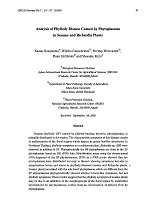Sesame phyllody (SP) caused by phloem-limiting bacteria, phytoplasmas, is primarily distributed in the tropics. The characteristic symptoms of this disease consist of malformation of the floral organs which appear as green leaf-like structures. In Northeast Thailand, phyllody symptoms on a rubiaceous plant, Richardia sp. (RP) were observed in addition to SP. Phylogenetically the RP phytoplasmas are close to the SP phytoplasmas based on 16S rDNA data. Hybridization assay using the chromosomal DNA fragment of the SP phytoplasmas, SP28, as a DNA probe showed that the phytoplasmas were distributed not only in flowers showing symptoms but also in symptomless leaves and stems in phyllody-diseased sesame and Richardia plants. Sesame plants inoculated with the udo dwarf phytoplasmas which are different from the SP phytoplasmas phylogenetically showed witches' broom-like symptoms, but not phyllody symptoms. These results suggest that the phyllody symptoms of sesame plants may be due to an inhibition of the morphogenesis of the floral organs by metabolites synthesized by phytoplasmas, rather than an interruption of phloem flow by phytoplasmas.

